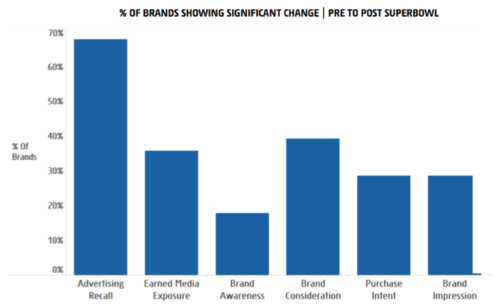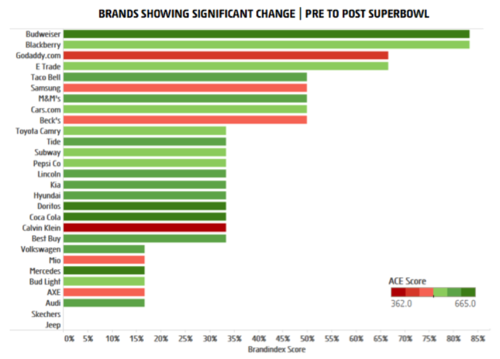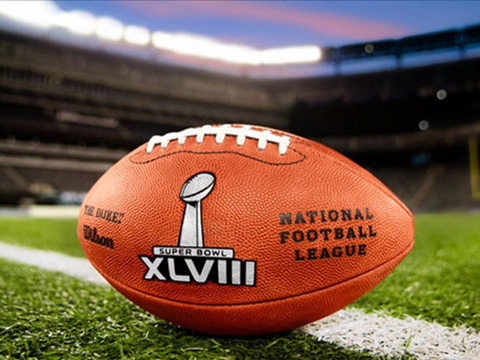Super Bowl advertising needs a few stars to align in order to demonstrate effectiveness against key health measures. Even if, and despite, the creative measuring well on paper, only 70% brands will even be recalled and of those, only 40% will show business-related responsiveness.

By Crossmedia Staff
OBJECTIVES
- What effect do Super Bowl commercials have, on average, against brand health measures?
- Which brands and categories are standout performers in 2013, if any?
- What effect does creative strength have on Super Bowl advertising effectiveness?
DATA EMPLOYED
- YouGov BrandIndex: daily health tracking data tracks the health of brands through daily nationally representative surveys that measure communication awareness, brand favorability and the consumer conversion funnel.
- AceMetrix’s Ace Score (Persuasion + Watchability): used to quantify creative effectiveness of individual Super Bowl commercials, in a uniform context.
METHODOLOGY
- Specific BrandIndex metrics were selected for analysis of the 28 Super Bowl 2013 advertisers based on appropriateness to the intended effect of Super Bowl advertising (and indeed most advertising): Advertising Recall, Earned Media Exposure, Brand Awareness, Brand Consideration, Purchase Intention and Brand Impression.
- An average of a 4-week period of daily survey data against a national average population was used to form a robust base (around 2500 respondents). The same period post airing was selected with the same number of respondents.
- Analysis of Variance (ANOVA) testing was employed to test for statistically significant positive change between pre and post survey responses.
RESULTS & INSIGHTS
- What effect do Super Bowl commercials have, on average, against brand health measures?
- Of all metrics analyzed, Ad Recall was unsurprisingly the metric that showed most significant increase. Nevertheless, there were over 30% of brands that got lost in the buzz and failed to show statistically significant improvement in Ad Recall. Of those 70% that succeeded, just over half went on to show strong increases in Earned Media Exposure, which of course is a key value component of Super Bowl advertising.
- Significant increases in Consideration were seen in around 40% of brands and Purchase Intent 30% of brands. Given the expectations of such a significant media investment, one would expect that relevancy and purchase intention gains might have been larger on average.
- Finally we also discover that Brand Impression – usually a sensitive function of advertising messaging – was only positively moved in around 30% of brands, which again is underwhelming given the focus to drive intense emotion during this premium advertising opportunity.

Which brands and categories are standout performers in 2013, if any, and what effect does creative strength have on Super Bowl advertising effectiveness?
- Budweiser and Blackberry were tied winners in significantly moving health metrics from pre- to post- Super Bowl advertising.
- Dot com brands (E-Trade, GoDaddy, Cars) came a close second in moving key health metrics
- As a category, Automotive fared least well, with the majority of Auto manufacturers moving few (in the case of Jeep, zero) key metrics. Perhaps this is the infrequently-relevant nature of the category and numerical competition during Super Bowl
- As can be seen by the color-coding distribution, there is no clear relationship between brand advertising effectiveness and creative strength (Ace Score). As a positive driver, it is best exemplified by the success of Budweiser. By contrast, Mercedes had a strong creative in theory but failed to move the needle in actuality. By contrast again, GoDaddy may have received a lower creative Ace Score (likely reflective of its polarizing content) but it managed to strongly move its brand and business metrics regardless.

CONCLUSION
Even if you are one of the 70% who is even remembered for advertising in the Super Bowl and can cut through the competition, the potential for conversion to business advantage quickly diminishes from there.
Getting noticed might mean creating something so controversial that people can’t help but take notice or simply put a .com at the end of your name!
Furthermore, although powerful creative will likely help a commercial perform above average, there are few guarantees. But that doesn’t mean you should avoid the big game all together.
It might be argued that the investment behind a Super Bowl commercial, although offering an alluring one-off opportunity to reach a captive audience at scale, is actually a risky business for the major advertisers that participate. Flexing media muscle or boxing out competition is probably not sufficient motivation. It is important to increase chance of through-the-funnel success by formulating a full campaign with significant earned and owned potential or utilize the spot to catapult an initiative that actually entices people to do something.
For more information, or help in understanding your media effectiveness, reach out to the Crossmedia Analytics team: lee.beale@xmedia.com


